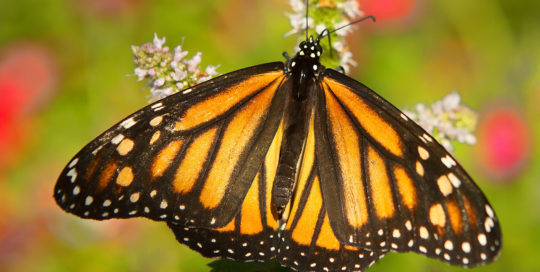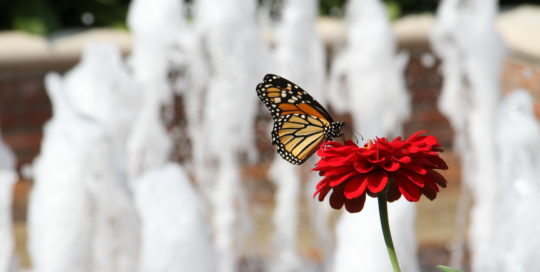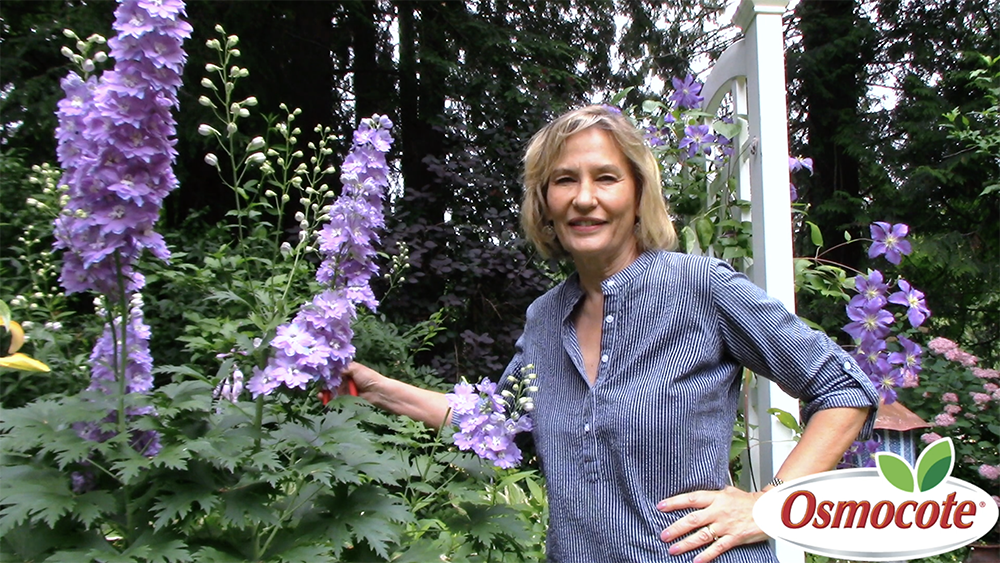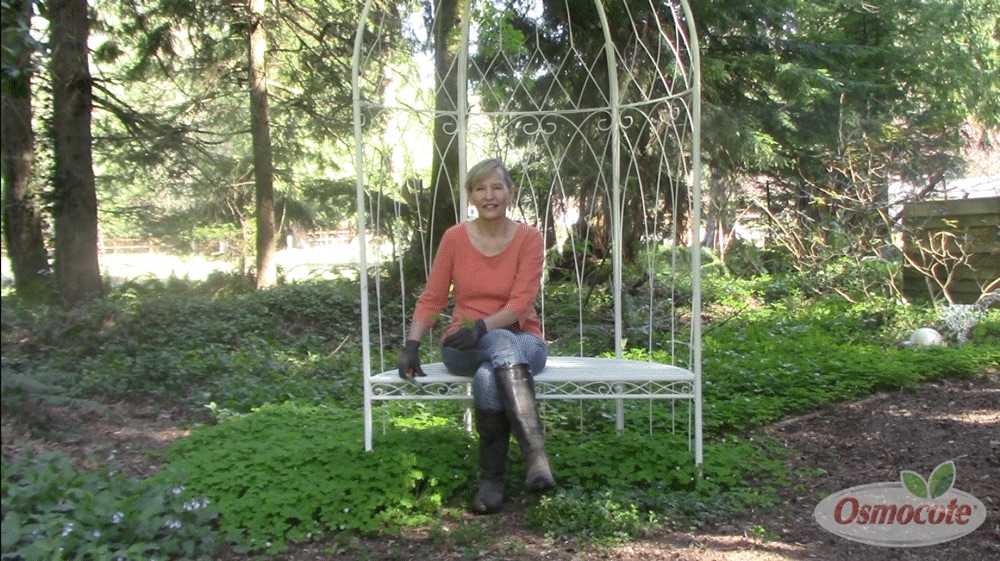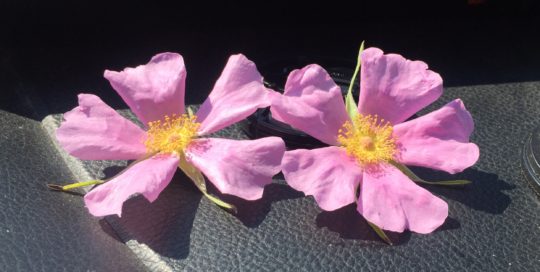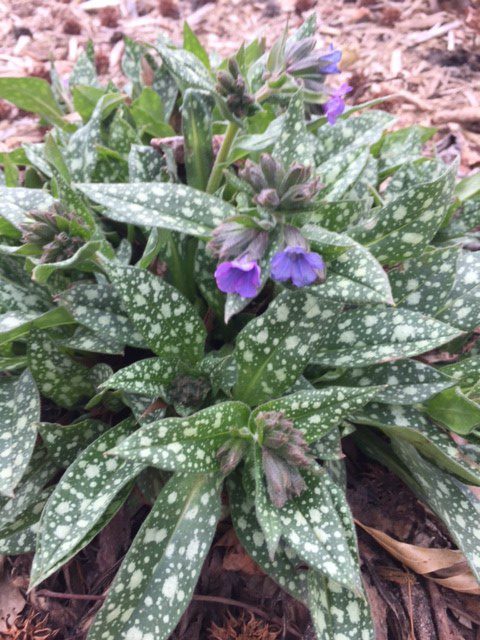Midwestern prairies are host to wonderful wildflowers that create a colorful tapestry among the tall grasses. Native prairie plants like coneflowers, ironweed, rudbeckia, butterfly weed, goldenrod and many others offer showy blossoms and a source of nectar and pollen for butterflies, bees and other insects. When they’re combined with native grasses, like little bluestem and prairie dropseed, these perennials offer a wonderful contrast in textures.
First, there’s the straight species—plants found growing in their natural habitat—like Echinacea purpurea (purple coneflower). And then there are cultivars, sometimes called nativars, like Echinacea purpurea ‘Magnus’. Cultivars of native plants have been created by breeders who cross different species to get something new and unusual. Other times they are selected from among thousands of the same plant in a growing field or in the wild. The plant may be selected or bred for a longer bloom time, bigger flowers, disease resistance or better overall form. Whether I’m growing the straight species or a cultivar, I find that these sun-loving perennials make my beds and borders more attractive to pollinators and to my fellow gardeners.
Here are just a few of my all-time favorites. Give them full sun (6-plus hours a day) and moist, well-drained soil. Prairie plants, once established are fairly drought-resistant.
Purple Coneflower (Echinacea purpurea)
Purple coneflowers have been a staple in our garden for many years because they bloom from June through October. They attract butterflies and make a great cut flower (if I can bare to cut them). When snow settles on the dried seed heads they look like they’re wearing little hats, and when it melts, goldfinches feast on the seeds. In the wild, purple coneflower is found growing in open woodlands and prairies, while pale purple coneflower (Echinaceapallida) is a primarily a prairie plant. Both are lovely and highly beneficial plants.
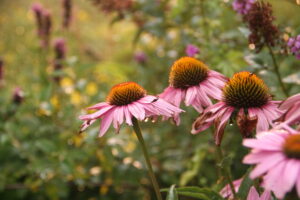
Coneflowers are very easy to grow from seed, but garden centers also sell them in pots. Some of my favorite combinations include purple coneflowers with calamint, phlox, blazing star (Liatris), prairie dropseed, and monarda. The large flat petals of the coneflower ‘Magnus’ offer a great landing site for swallowtail butterflies as well as tiny bees. Purple coneflowers are hardy from zones 3 to 8 and will grow 2 to 5 feet tall and 18 to 24 inches wide.
Prairie Dropseed (Sporobolus heterolepis)
Prairie dropseed is a stalwart of the tallgrass prairie. In its native habit, which includes much of the United States and Canada, prairie dropseed grows in full sun and mesic prairies (sites with soil that is medium-moist with good drainage—comparable to average garden soil), as well as hill prairies and dry, rocky soils. When the seeds have matured they drop from their hulls, giving rise to the plant’s common name, “dropseed.”
I love prairie dropseed for its form—a graceful, fine-textured mound. The 20-inch-long arching, narrow leaves create a fountain effect. In midsummer, it produces slender stems with pinkish-brown flowering panicles that float above the tufted grass. The flowers have a fragrance that has been described as buttery popcorn, roasted nuts, melted Crayons, or cilantro. The scent can delight or offend depending on your olfactory sense.
In the Warmth
Dropseed is a warm-season prairie grass, which means the leaves will not appear until warm weather in spring. The dried foliage and stalks should be left in place for winter interest. Cut the plants down to the ground before the new growth appears. Mature plants may be dug up after new growth begins, divided in half and replanted. Except for the short time between early spring and when new growth appears in late May, prairie dropseed is attractive for many months.
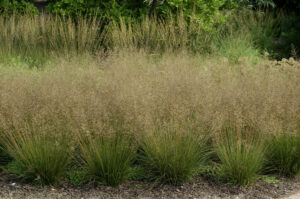
Once dropseed is established, supplemental watering is unnecessary unless there is a severe drought. From late summer into fall, juncoes and several types of sparrows eat the seeds in our garden. Plants are hardy from zones 3 to 9 and grow 2 to 3 feet tall and wide. ‘Tara’ is a compact cultivar that grows in a tight vase shape. It is shorter and more upright than the species. It grows one foot tall and wide, but in bloom it reaches two feet in height.
Ironweed (Vernonia)
Visit a prairie in late summer to fall and you’re sure to see an assortment of butterflies and an occasional hummingbird hovering over thick clusters of vibrant purple flowers. It’s likely ironweed—the common name for the genus Vernonia. Ironweed refers to the plant’s rigid stems that often remain upright during winter. Look past the quirky common name and you’ll discover a plant that’s not only a butterfly magnet, but one that deer and rabbits avoid.
The Vernonia plant is a rugged, drought-tolerant, long-lived perennial that can top seven feet or more in its native habitats. There are five species native to Illinois where we live. They grow in wet prairies, dry prairies, open floodplain woods, sedge meadows and along roadsides.
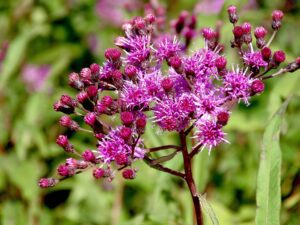
OLYMPUS DIGITAL CAMERA
In recent years, breeders have begun selecting and hybridizing ironweed in search of more compact plants, suitable for smaller gardens. Their long bloom time, attractiveness to pollinators and their late-season role in the sunny bed or border, make them a valuable perennial. The foliage is deep green and the flowers are purple-blue, but they’re sometimes described as purple-fuchsia. Flowering takes place for about a month or more. The plants attract native bees and several species of butterflies, including swallowtails, sulfurs, monarchs, painted ladies, skippers and others. Plants are hardy from zones 4 to 8 and grow 3 to 5 feet tall (or more depending on the species) and 1 to 2 feet wide.
Marsh Blazing Star (Liatris spicata)
Marsh blazing star is a wonderful plant for the sunny garden. The flowers are typically violet or light purple, sometimes with white-flowered cultivars. The upright, vertical stems offer a nice contrast to coneflowers and black-eyed Susans. In our garden, blazing stars attract butterflies, bees—and hummingbirds! The flowers open slowly from top to bottom over a period of a week or so and remain in bloom for more than a month. I leave the stalks standing for winter interest and for seed-eating birds. I like to pair blazing stars with milkweed, Culver’s root (Veronicastrum) and coneflowers. Although their common name—marsh blazing star—implies that they prefer wet areas, the plants will grow in moist, well-drained soil.
Buy blazing stars in pots or buy bags of corms for spring planting. Corms have a swollen stem base modified into a mass of storage tissue. Think of it as a starchy tuber that anchors the plant and stores food. When planting corms, notice the dry roots on the bottom and perhaps some pale green shoots sprouting at the top. Place the corms, leafy side up, about five or six inches below the soil surface and water plants while they become established.
All blazing star species are tough, drought-tolerant plants for sunny spots in the home garden. During extended hot, dry weather, the lower leaves may wither. Cut the dried stems to the ground in early spring before foliage emerges. One note of caution: emerging plants look like blades of grass in the spring so take care when weeding.
Plants are hardy from zones 3 to 8 and grow from 2 to 4 feet tall and 9 to 18 inches wide.
Sweet Coneflower (Rudbeckia subtomentosa)
Rudbeckia subtomentosa, commonly called sweet coneflower, grows in moist prairies, along stream banks and in low areas. It features daisy-like flowers (up to 3 inches wide) with yellow rays and a dark brownish-purple center disk. The common name, sweet coneflower, is a nod to the blossoms, which have a mild aroma of anise. They offer a long bloom period (summer to early fall) and attract pollinators to the flowers and birds to the dried seeds.
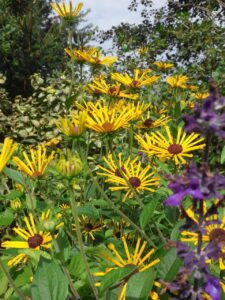
This easygoing native tolerates our hot, humid weather and has been deer-resistant in our garden. Two of my favorites are cultivars (Rudbeckia ‘Henry Eilers’ and ‘Little Henry’, a more compact plant,). A nursery grower, Henry Eilers, came across a very unusual flower form of this plant growing in a wet prairie swale in southern Illinois. The plant has unusual spoon-shaped ray petals. It dates to 2003. Plants are hardy in zones 4 to 8 and grow 3 to 5 feet tall and 1 to 2 feet wide.

